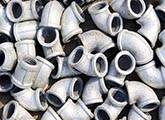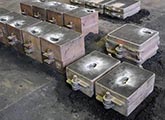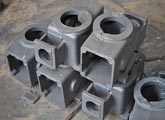Hollow Core Sand Casting
A core in sand casting is used to form the inner contours and cavities of the final sand casted product. Cores are normally disposal items which will be removed from the finished cast.
Used in both sand casting and metal injection molding, a stunning example of the use of cores can be seen in the casting of automotive engine blocks. This includes the GM V-8 engine, which requires five dry-sand cores.
 |
 |
 |
 |
 |
 |
On this page, you can learn more about:
- Types of Cores Used in Sand Casting
- The Use of Binders in Core Sands
- Important Considerations, Terms and Aspects
- Characteristics of a Core in Casting
Types of Cores Used in Sand Casting
The following types of cores are used in sand casting:
|
Green-sand cores are not typically used in core sand casting. The main disadvantage of green-sand cores is that they are not very strong. Which makes the casting of narrow and long features extremely difficult, if not impossible. Typically, application is made through a hole in a casting. These core types, in the cases where they are used to cast long features, result in a need for post-casting machining. |
|
|
Dry-sand cores, meanwhile, are formed independently inside the mold. After which it is inserted into the mold’s core prints, which are responsible for holding the core in position. The simplest method of producing dry-sand cores is using a dump core box. The core segment of which is now baked or hardened. At which point multiple core segments are either hot glued together or attached using various other means and techniques. Rough spots on the core are then filed and sanded down. Before the cores are lightly coated with graphite, mic, or silica. This increases heat resistance and offers a smoother surface finish. In cases of single piece cores, no assembly is needed as they are produced by making use of a split core box, made of two halves and featuring at least one hole through which sand can be introduced. Special core producing extruders are applied in cases where a simple core with constant cross-sections are required. These extrusions are then cut to the desired length and hardened. |
In the case of more complex single piece core sand casting, a technique similar to that of die casting and injection molding is used.
Characteristics of Cores in Sand Casting
A core used in sand casting must:
- Have a smooth surface finish.
- A minimum production of gasses released during the pouring of the molten metal.
- A high permeability to allow the gasses produced during pouring to sufficiently escape the cast.
- Weak enough to break down as the material starts to shrink.
- Because the core itself is surrounded by molten metal during the sand casting process, a good refractoriness is essential.
- Cores must be easy to remove during the shake-out step in the process.
- The core, in its hardened state, is required to handle to forces caused by casting. Its compression strength is required to be between 100 psi (0.69 MPa) and 300 psi (2.07MPa).
- Sufficient strength is required for hardening (in the green condition).
Important Considerations, Terms, and Aspects of Sand Casting Cores
Internal wires and rods can be used to increase the strength of cores. While straw can be added to the middle of the core to enhance its collapsibility.
A hollow core can also be used to enhance collapsibility, which is an important aspect in steel castings, as a large amount of shrinkage is present when sand casting steel.
Except for very small cores, all cores do require the presence of vent holes to enable the proper release of gasses formed during the pouring process. This is usually achieved by making use of very small wires, which serve to create holes from the surface of the mold to the core itself.
In cases where wires cannot be applied for creating venting holes, coke, and cinder can be added to the core - this will result in an increased permeability.
|
Chaplets |
In cases where a core in the sand casting process only makes use of one core print, chaplets are used to deliver the required core support. Chaplets are small, metal supports used to bridge the gap between the core and the surface of the mold. This technique results in the supports (or chaplets) becoming a part of the final casting. Because of this, the chaplet material must either be made of the same, or similar, material of that being poured during the sand casting process. Optimized designs are required when making use of chaplets. Too small, and the chaplets will melt completely, resulting in the core moving from its required position. Too big, and these chaplets' surfaces cannot fuse or melt properly with the material being poured. The use of chaplets can cause defects and weak spots within the final casting. |
|
Cheeks |
In cases where a reentrant angle is required, cheeks are used instead of cores. A third segment in the flask (an addition to the drag and cope), cheeks allow the entire sand casting mold to be produced from green sand and removable patterns. A disadvantage associated with cheeks is that it requires an increased mold making process. However, this can be a beneficial aspect when low quantities of castings are required. In cases where a high quantity of casts is required, it is a more economically sound choice to make use of cores. |
Further Reading: